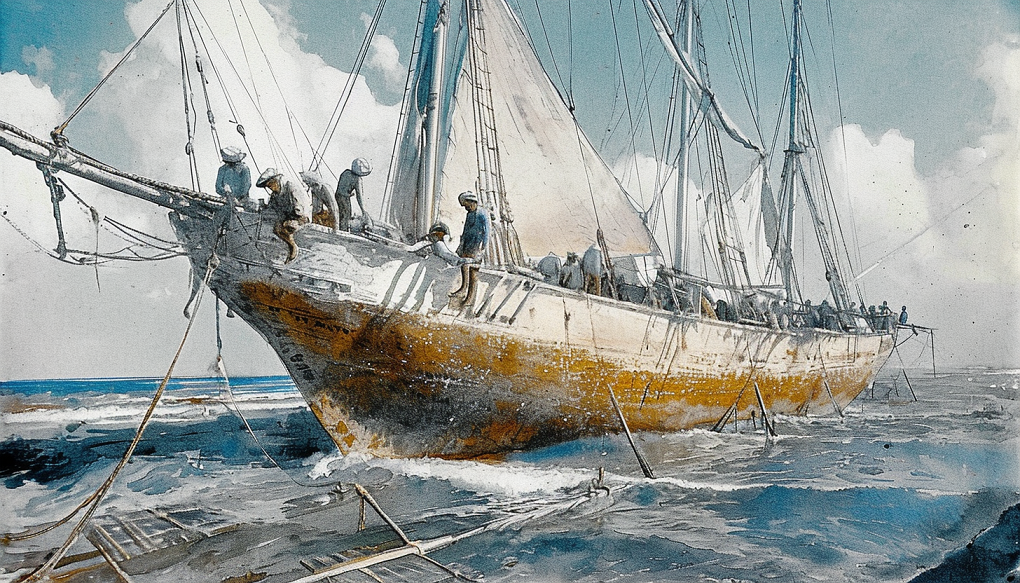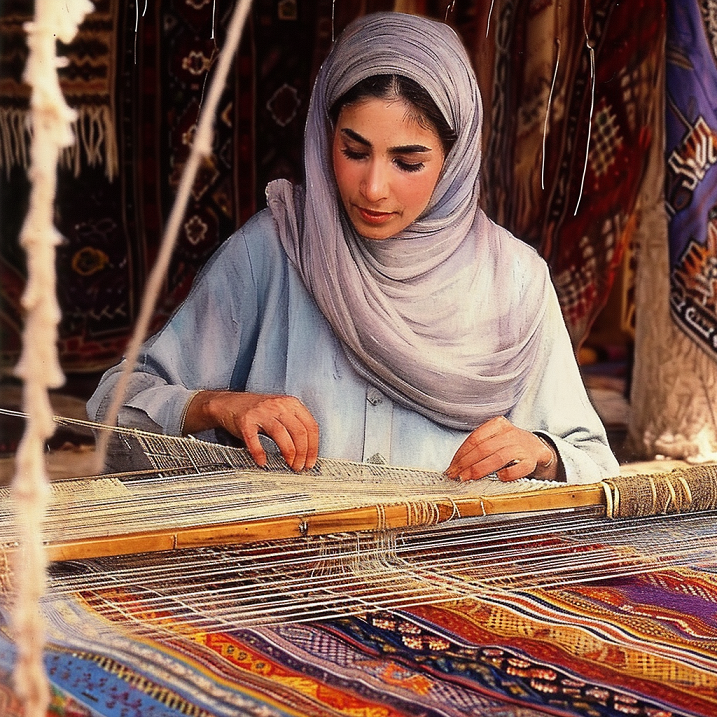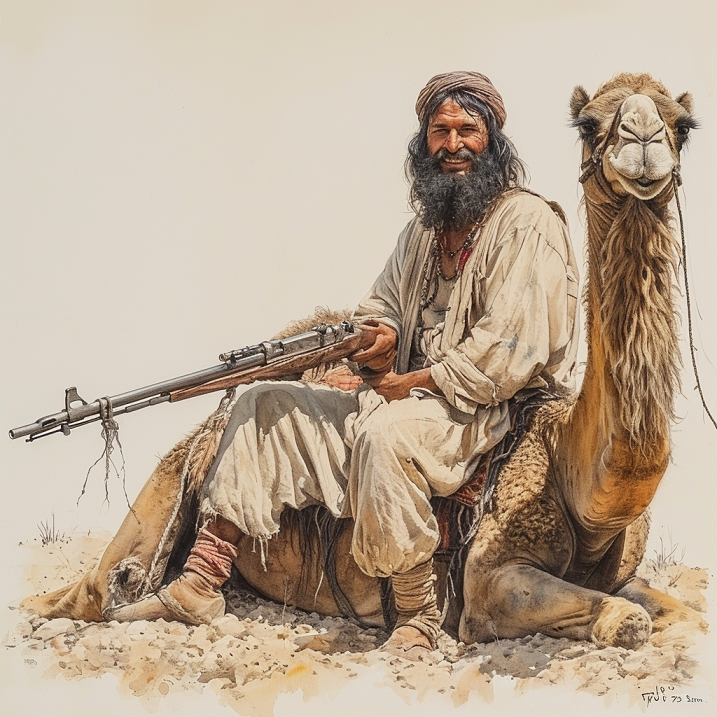James Wellsted, in his travelogue “Travels in Arabia,” takes us on a journey to the hot springs of “Imam Ali Cove of Muscat,” an adventure that unfolds against the backdrop of the early 19th century. On a scorching day in November, James Wellsted embarked on an expedition to the hot springs, nestled along the sea-shore, a seven-hour westward journey from the bustling town of Muscat.
Key Takeaways:
- Bedouin Culture: Bedouin tribes in Oman were distinguished by their fair complexion, striking attire, and warrior-like demeanor.
- Hot Springs Mystique: The hot springs of Imam Ali Cove, with their scalding waters and mysterious qualities, were believed to possess therapeutic properties.
- Local Rituals: Patients at the springs underwent intense submersion and believed that persistence was key to healing.
- Ruwi’s Occupation: Ruwi’s inhabitants were primarily engaged in cloth weaving and the production of woollen cloaks, a prominent industry in the region.
- Freedom of Demeanor: Women in Ruwi moved about with uncovered faces, showcasing their regular features and contrasting with traditional veiling customs.
Despite the advanced stage of the cool season, the day proved to be excessively sultry, enveloping the explorers in an almost overpowering heat. As they set out in a small boat, the cove presented a “glassy surface”, so smooth that it mirrored the surrounding landscape with startling clarity, an effect intensified by the tranquil waters within. However, the cove’s serene appearance belied the fierce glare of the midday sun.
The town of Muscat lay silent and at rest, its inhabitants seeking refuge from the sweltering heat. Occasionally, a lone fisherman could be spotted in a small canoe, casting his net and pursued by the laughing sea-gull, known for its wild, shrill cry. As they navigated the waters along the base of the mountains, the heat emanating from the rocky cliffs added to the intensity of the journey.
Intriguingly, the scene took an unexpected turn as they rounded a rocky bend, revealing a massive “bagala” (ship). This vessel, unlike any other, was a sight to behold, with its single mast and sail spanning an astonishing 150 feet in length. Upon boarding, expecting to receive some letters to pass on Wellstead observes:
The decks appear crowded with beings of every hue, and from every clime. The Persian, distinguished by his flowing and richly-coloured dress; the Arab, with his coarse cloak of broad alternate stripes ;the Beluche,with his long hair and white garments; and the Armenian, who affects a costume bearing some resemblance to the unsightly garb of the Franks, are mixed up with, and jostled by African negroes, who have but a piece of tattered cloth thrown around their waist.
James Wellsted: Travels in Arabia

On board, the diverse crew, while working, engaged in a curious blend of song, music, and dance, accompanied by rudimentary musical instruments. Their cacophonous performance seemed inharmonious to Wellsted, yet it carried a mesmerising effect on the African crew members, who expressed an intense connection to the music through their expressive faces, wild gestures, and prolonged dancing.
To the European, scarcely any combination of sounds can appear farther removed from music, or, indeed, more thoroughly discordant, yet on these Africans their effects appear indescribably exciting. The expression of the face, the contortions of the limbs and body, the yells with which their dancing gestures are accompanied, and the length of time they will continue the exercise, in fact until they sink down in a state of exhaustion, denote an in tense sympathy with sounds to which we are equally strangers.
James Wellsted: Travels in Arabia
As they continued their voyage, the boat passed the fortifications that guarded the cove’s entrance, and the thunderous echoes of artillery fire resonated in the air, creating a magnificent and deafening spectacle. Wellsted noted the striking contrast between the massive naval vessels, including a seventy-four gun ship and heavy frigates, and the seemingly insignificant hillocks that formed the cove’s backdrop.
The journey continued as they entered the bay of Mutrah, a picturesque town nestled within the rocky terrain, distinguished by a broad belt of light-colored sand, and connected to Muscat by a rugged road. Wellsted’s narrative offers a glimpse into the town’s weaving industry, where its inhabitants, with faces uncovered, diligently spun thread and wove woolen cloaks—a stark contrast to the veiled and reserved demeanour observed in many Arab towns.
Scarcely a hut but contained its spinning-wheel, with a female busily employed before it. All had their faces uncovered : their features were regular, and, in many cases, handsome, but the effect is, in a measure, destroyed by the absurd practice of dying the skin with henna.
James Wellsted: Travels in Arabia

Journey to Ruwi Village: the Bedouin Way of Life
Leaving behind the beguiling sights and sounds of the enigmatic bagala, James Wellsted’s expedition continued its westward voyage towards the hot springs of Imam Ali Cove. Their path led them through rugged and unforgiving terrain, offering a stark contrast to the maritime splendours they had just witnessed. Along this arduous journey, they encountered groups of Bedouins and embarked on an exploration of their unique culture, physical attributes, and the hospitality of the Ruwi village.
One of the most intriguing aspects of this part of the journey was the encounters with the Bedouin tribes, particularly the Beni Wahab. These desert-dwelling nomads exhibited striking physical characteristics, setting them apart from the inhabitants of other Arab regions. Notably, the Bedouins in this area possessed a fairer complexion, a trait rarely observed among their settled Arab counterparts. Their stature, though on the shorter side, was well-proportioned and conveyed an air of martial prowess.
The Bedouins’ attire and demeanour also captured Wellsted’s attention. Draped in flowing robes, they exuded a distinct sense of style and a timeless connection to their nomadic heritage. Particularly striking were their long hair, allowed to cascade in plaited folds down to their waist, a practical choice for protection from the harsh desert elements. Their overall appearance, accentuated by the presence of swords and shields, conveyed a sense of warrior-like nobility. When seated atop their war camels, cross-legged and adorned with their traditional gear, they formed a picturesque and formidable sight.
They have dark, lively, expressive eyes; a well-formed nose and mouth ;and their pearly white teeth offer a fine contrast to those of the town Arabs. They seem a laughing, good-humoured race, and chatted freely, as I rode at their side, of their country and its inhabitants.
James Wellsted: Travels in Arabia

As the expedition ventured further into the interior, they reached the village of Ruwi, a settlement nestled within this rugged landscape. Ruwi, though remote and isolated, held a unique charm of its own. It was a place where travellers could find solace and accommodation amidst the harsh conditions of the desert. The village boasted gardens and wells, offering respite to those who dared to venture into this challenging terrain.
However, what truly distinguished James Wellsted’s journey was his remarkable choice of lodgings. Instead of seeking shelter in the conventional confines of a building, he opted for an unconventional yet authentically Bedouin experience. As the night descended and the cold air settled in, he eschewed the comforts of a roof over his head. Instead, he wrapped himself in a boat cloak and reclined on a platform, raising himself above the ground and embracing the open air.
Exploring the Hot Springs: A Natural Oasis in Oman
Having journeyed through the rugged terrain of Oman, James Wellsted and his expedition party arrived at the destination that had piqued their curiosity—the hot springs of Imam Ali Cove. This natural wonder, situated amidst the stark beauty of the Arabian desert, offered respite and fascination in equal measure.
As the explorers approached the hot springs, they were greeted by the sight of water gushing forth with remarkable force from an opening at the base of a hill composed of clay ironstone. This geological feature, adorned with veins of crystallized quartz running diagonally through the rock, held an otherworldly charm. Large fragments of the rock had been dislodged by the ceaseless flow of water, creating an environment that hinted at nature’s power.
Intriguingly, although the location exhibited signs of geological activity, there were no discernible traces of volcanic action. While some faint indications of copper could be glimpsed between the inner layers of rock, the hot springs’ primary characteristic was their scalding temperature. As an immersion into the springs revealed, the water’s temperature soared to an astonishing 45 degrees Celsius, a testament to the geological processes at work beneath the surface.
Wellsted’s keen observations extended to the taste and smell of the spring water. After numerous attempts to discern any specific qualities, he found it challenging to definitively categorize the water. At times, it hinted at containing iron, and at others, it exhibited no more salinity than the water found in other regions. In both instances, Wellsted’s conclusions were marked by uncertainty, highlighting the unique and enigmatic nature of these springs.
For the native population, however, there was no ambiguity about the qualities of the hot spring water. The Bedouins and town Arabs held the belief that these waters possessed potent healing properties. They had faith that the springs could alleviate various skin disorders, and this faith led them to undertake arduous journeys to reach the springs. Some Bedouins would travel great distances from the interior, enduring hardship to access the soothing waters.
As a cure for cutaneous and other local disorders, these waters enjoy a great reputation amongst the Bedowins and town Arabs, the former frequently undertaking long and painful journeys from a great distance in the interior, that they may remain and use them for several days.
James Wellsted: Travels in Arabia
Wellsted’s observations also extended to the intriguing rituals surrounding the hot springs. Patients seeking therapeutic benefits would immerse themselves in the scalding water. In a surprising and sometimes rough procedure, they were held underwater against their will for extended periods. The locals believed that if the springs did not produce the desired effects, it was only because they had not been utilized rigorously enough.
One poignant episode that Wellsted noted was the submersion of an elderly man of eighty years. This individual had been subjected to the treatment so intensely that he appeared to be on the verge of death. However, local belief dictated that if the first attempt did not succeed, the treatment would be repeated after a brief interval of two hours. This dedication to the perceived healing properties of the springs exemplified the resilience and unwavering faith of those who sought their benefits.

In tracing the footsteps of James Wellsted through the pages of his vivid narrative, we have embarked on a captivating journey into the heart of 19th-century Oman. Wellsted’s unwavering commitment to understanding and embracing the local customs has allowed us to witness the desert’s vibrant life and its resilient inhabitants. Through his remarkable voyage, we are reminded that the spirit of exploration and cultural immersion remains an enduring testament to the enduring allure of the Arabian sands.
FAQ:
Q: What made Bedouin tribes in Oman distinctive?
A: Bedouins were distinguished by their fair complexion, unique attire, and a warrior-like demeanor.
Q: Why was Ruwi village significant during the harvest season?
A: Ruwi became a bustling hub, with a population surge as town Arabs flocked to the village, celebrating the season of abundance.
Q: What did James Wellsted’s choice to sleep in the open air signify?
A: It reflected his commitment to cultural immersion and a desire to understand the local customs and way of life.
Q: What were the therapeutic beliefs surrounding the hot springs of Imam Ali Cove?
A: The locals believed that persistence, including intense submersion, was key to harnessing the healing properties of the scalding waters.
Q: What was the primary occupation of Ruwi’s inhabitants?
A: The people of Ruwi were primarily engaged in cloth weaving and the production of woollen cloaks, a significant industry in the region.

